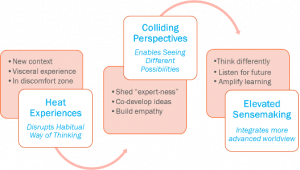 High-potential, or HIPO, employees are 90 percent more valuable to organizations than their peers, yet in its 2015 “Beyond the HIPO Hype” release, the Corporate Executive Board suggests that 73 percent of HIPO development programs fail. Ouch.
High-potential, or HIPO, employees are 90 percent more valuable to organizations than their peers, yet in its 2015 “Beyond the HIPO Hype” release, the Corporate Executive Board suggests that 73 percent of HIPO development programs fail. Ouch.
Organizations can improve outcomes for their HIPO development programs, but they must engage HIPOs with the right mix of high-risk, high-reward development opportunities. These development activities are visible, important, challenging and place individuals in assignments where their potential can be applied. But exposure to these experiences isn’t enough. What really drives HIPOs to perform better in the future is the learning they extract from the experience.
Let’s start with high risk experiences. The stretch inherent to risk fosters development beyond new information, skills and competencies, to a growth often referred to as vertical development. This enables a mindset shift and a more expansive way of thinking. This distinction is increasingly important because many of the challenges business leaders face today are adaptive, meaning they are not the routine run-of-the-mill problems we have faced in the past; leaders need to think and act differently.
Many HIPO development practitioners say talent identification is key, while overemphasizing the importance of past performance is not always the best predictor of future success, given the hyperpace of change we are experiencing. This also can result in investments in the wrong people, wasting limited resources and impacting program success.
We advocate for development strategies that include vertical stage development because it helps program designers and participants understand if their leaders exhibit the growth mindset needed to handle unforeseen challenges in the future.
Three conditions support vertical development:
- Heat experiences: These are times when a situation prompts a visceral reaction, a feeling in the pit of the stomach or a moment where you might literally reach for a metaphorical seat belt because you know it will be a bumpy ride. These unsettling moments are when learning can really take hold.
- Colliding perspectives: These are situations where you step outside of yourself and really try to develop an alternate point of view by working with others.
- Elevated sense-making: Allow time for reflection by yourself, with peers or with a coach to maximize the extraction of insights from an experience to complete the learning cycle.

The heat is an essential catalyst to trigger growth and development in rising talent. So how do you turn up the heat? In 2015, to find an answer, Center for Creative Leadership interviewed a panel of 30 experts. Raising the heat was defined as helping a participant face a complex situation that disrupts and disorients his or her habitual way of thinking; discovering that his or her way of making sense of the world may be inadequate; and opening the participant up to new or better ways to make sense of the challenge. The panel found that manufacturing heat in the classroom was sometimes necessary to achieve this condition.
Most HIPO program experiences are comfortable rather than heated; they make the participants feel good and not uncomfortable. It’s a brave learning professional who designs for discomfort because that is where the learning happens. It might not always translate to a 5 on a 5-point scale evaluation at the end of the day, but it will have longer lasting impact.
The Case-in-Point method popularized by Ronald Heifetz, founder of the Center for Public Leadership at Harvard Kennedy School, provides an example of turning up the heat and extraction of learning. Case-in-Point puts smart, task-focused leaders in a workshop with no prescribed goal, no structure and no authority figure to tell them what to do — “You are the leaders, begin.” Chaos ensues as participants realize that to make sense of their situation, they must speak up, find partners and work through conflicting agendas in the room. Leaders learn how to lead when no one has to follow.
Leadership is difficult, and there aren’t many environments where learners can experiment. Here, participants learn and practice competencies necessary to make progress while working within an intense group setting. These competencies center on diagnosing a situation, managing self, energizing others and intervening skillfully. Participants also learn to recognize their default responses, and identify productive and unproductive behavior patterns. With Case-in-Point, the extraction of the learning is even more powerful than exposure to the experience, increasing participants’ ability to apply the learning.
In “Beyond the HIPO Hype,” CEB emphasizes that a high-quality learning experience in development programs combined with a thought-provoking extraction of learning from the experience can lead to as much as a 30 percent increase in performance. With these results, the value of the HIPOs in an organization goes from simmering to scorching hot.
Anita Bhasin is the founder and CEO of Sage Ways. To comment, email editor@CLOmedia.com.















